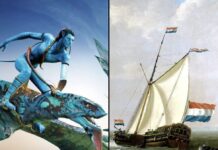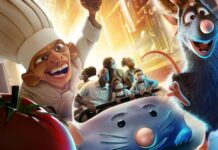The dynamic partnership of director Edgar Wright and actors Simon Pegg and Nick Frost has kept audiences laughing ever since the release of 2002’s horror-comedy Shaun of the Dead. Their unique brand of genre satire and sharply written jokes was followed up with 2007’s buddy-cop satire Hot Fuzz.
This year, they have done it again with The World’s End. In this final chapter of the so-called “Three Flavours Cornetto” trilogy, five old friends from college return to their sleepy hometown in the English countryside to attempt an epic pub crawl called “the Golden Mile” they attempted int their youth, only to find out that the townspeople have been replaced by pod people-esque androids. Paddy Considine, Eddie Marsan, Rosamund Pike, and Sherlock’s Martin Freeman star alongside Wright regulars Pegg and Frost, with special cameo appearances by Pierce Brosnan and Bill Nighy.
Prior to the film’s release, Pegg was quoted in an interview as saying that before they pick the genre, they write the screenplay, not the opposite, as some may have suspected. While viewing the film, Pegg’s comments are proven true; the plot focuses less on the fact that alien androids have taken over the town and more on the characters. Pegg himself plays a man who is still stuck in his university days from the nineties, sporting a “Sisters of Mercy” tattoo, dressing as if he were a character from The Matrix, and even driving the same beat-up car. He is also portrayed as an alcoholic, hedonistic shell of a man desperately trying to relive his glory days.
In a nice role reversal, Frost plays an excellent straight man to Pegg’s oddball leader, and as always, the two have fine chemistry. I found myself genuinely impressed at Frost’s ability to play the straight man after two consecutive roles playing a wacky funny man; his experience in his college days make him and Pegg a comedic yin and yang. The writing itself is as sharp as ever, and the jokes are paced well to allow for story development and prevent the jokes themselves from going stale, which I find to be a problem plaguing many modern comedies. Wright never tries to “dumb down” the jokes; rather, he uses clever wit and dry humor to create intelligent jokes and make the audience laugh.
What I appreciated most about the film was its effective use of minutiae both aesthetically and to communicate the ongoing theme of “many acting as one,” and the playful subversion/satire of sci-fi tropes. Wright is well-known for using subtle visual references and Easter eggs in his films: Shaun of the Dead has sly references to hallmarks of the horror genre and summed up the plot of the film early on with a single line from Frost’s character Ed, and Scott Pilgrim versus the World boasted a list of references to the “number” of the character’s heroes and villains. The World’s End is no exception.
The pod-people type villains bleed a blue “blood” when harmed or destroyed, and throughout the film blue colors can be seen everywhere. Some of the bots have blue eyes, there are shades of blue in the character’s clothes, there is blue in the street lights, there is blue carpeting in some of the pubs, many of the pubs have blue signs, there’s too much blue for me to list here. Some references are one-off jokes; one of the pubs (the Old Familiar) closely resembles a previous pub (the First Post). Even the first attempt at the Golden Mile is referenced in the film, but you’ll have to see that for yourself as the details are spoiler-ridden.
But these only serve to help illustrate what I think of as the theme of the film and of the trilogy as a whole: the conscious collective of a large group of people sharing the same goals. Shaun of the Dead approached this from the zombie-horror genre, where the collective of zombies banded together with the goal to eat brains, Hot Fuzz approached it with the use of the Neighborhood Watch Association who used lethal measures to preserve the façade of cleanliness and wholesomeness of their small English town, and The World’s End approaches it with the androids, to great effect.
Like Hot Fuzz, you can understand and sympathize with why the alien race is taking over this seemingly unimportant town (Wright slyly references this in the scenery), but why they pursue this goal is so ridiculous and humorously over-the-top you can’t help but laugh at their plans. Overall, The World’s End is another shining example of cinematic comedy and a fitting end to the “Three Flavours Cornetto” Trilogy.
Rating: A-









